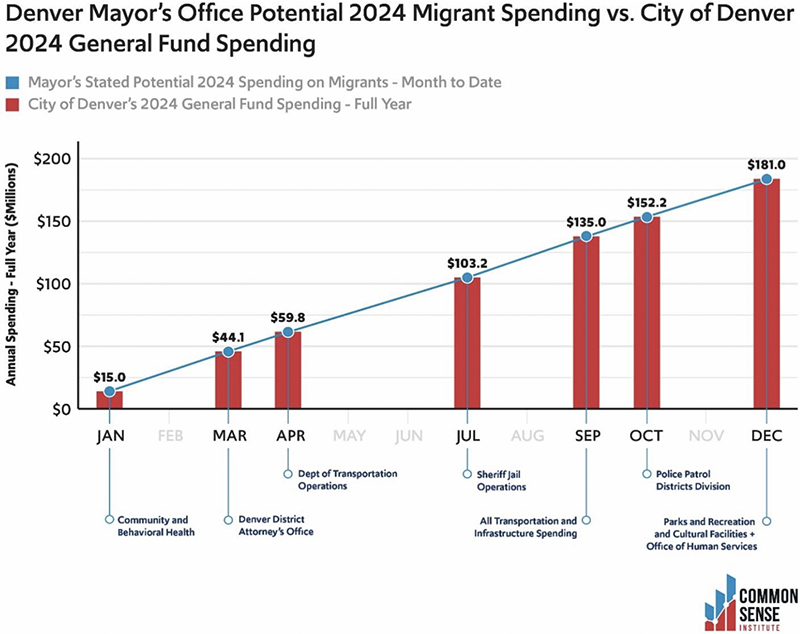America’s southern border crisis is impacting Denver in a big way. If the Denver mayor’s recent spending projections of $180 million hold true, the city will have spent several city departments’ worth of general funding by the end of 2024. This total would amount to over $500 per Denver household.
In FY2023, there were more than 3.2 million migrant encounters at U.S. borders, a number nearly equivalent to the total number of babies born in the country in 2022 (3.6 million). With over 35,400 migrant arrivals in Denver since January 2023, Colorado has the highest level of migration relative to population of any state not on the southern border.
Migrants have been arriving at record levels for more than 14 months. The City is providing a range of services, including shelter and food, and coordinating with local non-profits. The total City expense in 2023 was more than $36 million, within the range estimated by CSI in October
[i]. The cost is growing as new shelters open and the city begins covering some migrants’ rent (one month of rent for migrants with jobs and three months of rent for those without)
[ii]. The City is opening a new congregate shelter but wants to transition migrants to permanent shelter from there.

Though the mayor’s budget proposal in October included a plan to start the year with $20 million set aside for spending on migrants,
[iii] his presentation to the Denver City Council on January 2
nd indicated that the City could spend more than $180 million on migrants in 2024. To date, spending has come from a combination of federal, state, and City funds, but it is unclear how the city would be able to spend the projected 2024 amount.
- If the Denver mayor’s cost projections played out in real time, the city’s spending on migrants would equal the spending levels of various city departments over time:
- $15 million by January – General Fund spending for the Denver Department of Community and Behavioral Health
- $44.1 million by March – General Fund spending for the Denver District Attorney’s Office
- $59.8 million by April – General Fund spending for the Denver Department of Transportation’s operations
- $103.2 million by July – General Fund spending for the Denver County Sheriff jail operations
- $135 million by September – All City of Denver transportation and infrastructure spending
- $152.2 million by October – Denver Police Patrol Districts Division spending
- $181 million by December – Department of Parks and Recreation and Cultural Facilities PLUS the Office of Human Services
City of Denver spending alone does not fully account for money and resources spent in Colorado. The mayor’s estimate does not include spending by non-profits, hospitals, and first responders. For example, Denver Health reports a surge in the number of patients from Central America but has not publicly released any figures on how much that care may cost.
Denver is not alone. Carbondale received $5 million funding an influx of Venezuelan refugees
[iv].
The Mayor’s Office’s projections are alarming but highly uncertain. The monthly amount under the $180 million annual projection ($15M) is over five times the reported December 2023 spending. According to the same CSI model that accurately predicted the City’s total migrant spending through last December, additional spending through 2024 could reach $55.5 million at the current rate of daily arrivals. Budgets reflect policy choices. Policy makers and the public should carefully weigh trade-offs prior to turning projections into budgetary commitments.
RESOURCES
[i] https://commonsenseinstituteco.org/denver-migrant-sheltering/
[ii] https://www.denverpost.com/2024/01/04/denver-migrant-camp-zuni-street-cleanup/
[iii] https://www.denvergov.org/files/assets/public/v/2/finance/documents/budget/2024/final-september-2024-budget_9.14.23.pdf
[iv] https://www.9news.com/article/news/local/next/next-with-kyle-clark/125-migrants-arrive-carbondale-overwhelmed/73-45446cc6-4205-4df6-b7cf-218fb2507842